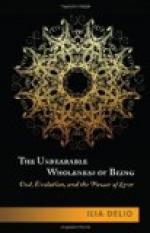It is remarkable that Dante, too, wrote a poem clearly expressive of the fact that the beloved woman does not actually possess the qualities ascribed to her, but that she has been endowed with them by the imagination of her lover.
I shall discuss the emotional life of only one other poet in detail, and that one is Michelangelo. For the most part the poets whose emotions were akin to that of Dante and Goethe were men who created their ideal woman because reality left them unsatisfied. In passing I will mention Beethoven, and his touching letter to his “immortal love” ("My angel, my all, my I!"), whose name, in spite of all the strenuous attempts to discover it, is to this day not known with any certainty; even if it should ever be discovered, Beethoven’s “immortal love” will yet remain a figment of his brain, based on a human woman.
Together with Beethoven, we may notice the other great “old bachelor” Grillparzer, and his eternal fiancee Kathi Froehlich, and the critical Hebbel, who at the time of composing “Genovefa” wrote in his diary: “All earthly love is merely the road to the heavenly love.”
Before closing this chapter, I must draw attention to a strange fact in connection with the psychology of races. All nations endowed with fair mental gifts and a sympathetic understanding of nature, have in the period of their youth and anthropomorphistic and animistic thought worshipped light, and its source, the sun, as the supreme deity, the giver of joy and abundance. All the benevolent deities of the Arians were celestial beings, all the malevolent divinities spirits of darkness: Olympian gods and the demons of the netherworld—Aesir and Giants. To the naive mind of the Indo-Germanic races it appeared a matter of course that the sun, the conqueror of night and winter, the fertilizing, life-giving deity, should be worshipped as the active male principle, and represented as a god, while on the other hand the moon was usually conceived as a female deity. In primitive Christianity Christ, as the bringer of light, was worshipped under the symbol of the sun. Thus we naturally find in the old and new Indo-Germanic languages the designation of the sun—or the sun-god—of the masculine gender. In the following words our word sun is easily recognisable:
Savar and svari (the oldest Indo-Germanic tongue). svar and surya (Sanscrit; savitar—the sungod). saval (the oldest European language). savel (Gracco-Italian). sol (Latin and related languages).
In the Germanic languages and in the Prussian-Lithuanian both genders occur. (Gothic sunnan and Old High-German sunno). Sol in the Norse Edda is a female deity, and the Anglo-Saxon sol is also feminine. The transition from the male to the female gender was achieved in the Middle-High-German language of the twelfth and thirteenth centuries, and the German language is the only one in which the word sun is feminine. As the old Teutonic deities of light




